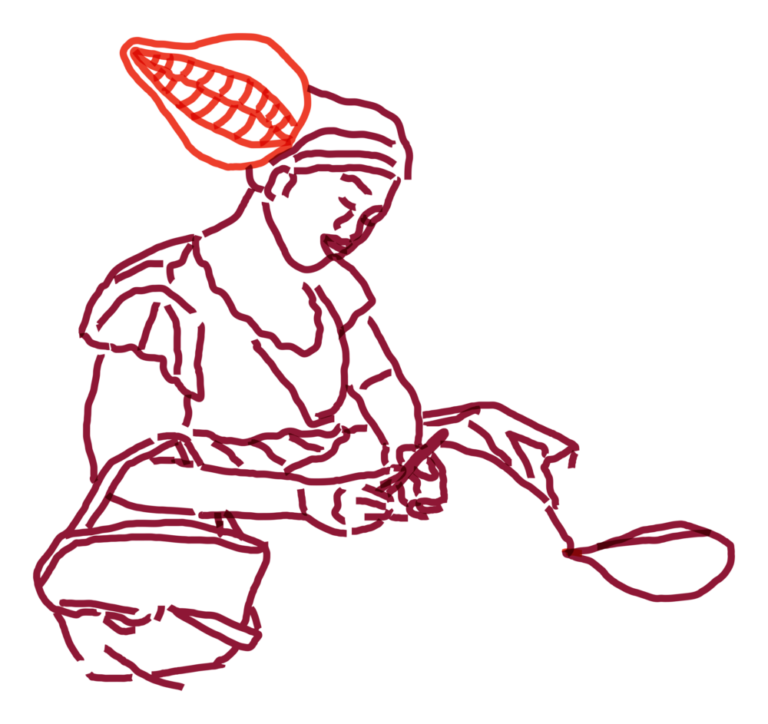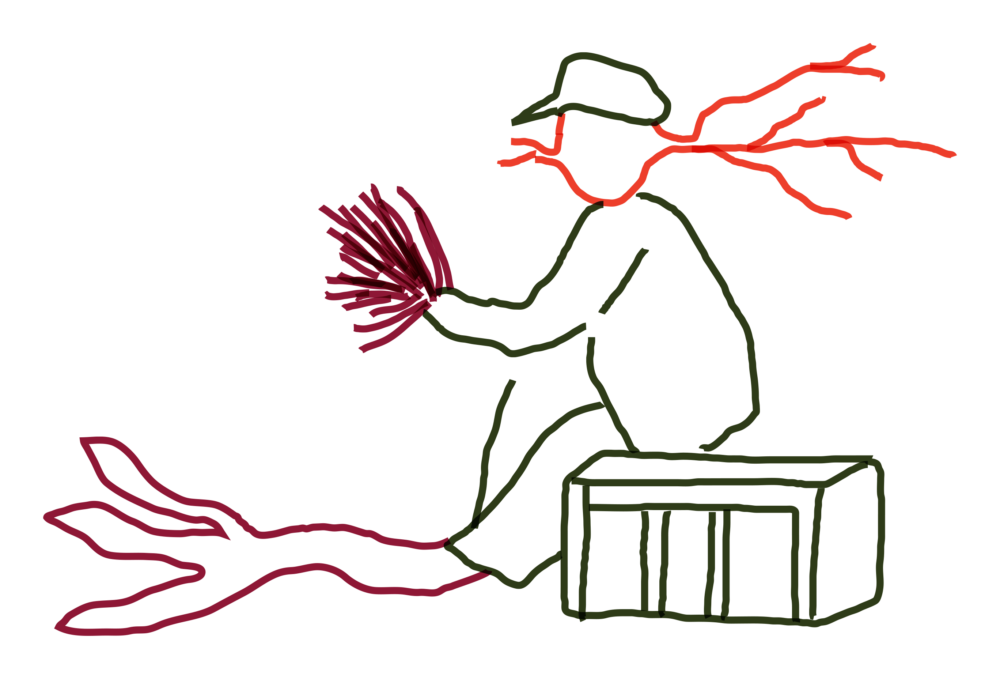Iatrosophia: On folk medicine and phytogeography
 *Illustration by Christos Kotsinis, Art Pluriverse II, BoWB, CC BY-SA 4.0*
*Illustration by Christos Kotsinis, Art Pluriverse II, BoWB, CC BY-SA 4.0*
Curatorial text by Mariana Ziku, Elli Leventaki, Katerina Zachou
Folk, traditional or popular medicine is understood as a sociοcultural process of community transferred knowledge that is based on a variety of grassroots health care practices (Hionidou 2016), including but not limited to, the use of plant and herbal species, natural elements, technology as well as oral and performative rituals. Folk medicine reflected the applied use of local wisdom for communal well-being, forming a part of socio-ecological livelihoods and their everyday culture.
Balkans have a long history of medical culture (Živković et al. 2020) related to the ethnobotanical knowledge and phytogeography of the region. Plants’ medicinal, economic and anthropological importance is reflected in the sound knowledge of their diversity and use (Jarić et al. 2018), providing a deep understanding of how socio-ecological microsystems work and affect the human environment-biota relations (Pieroni 2014). The folklore documentation of plant and herbal records, their traditional local names and uses, real and symbolic, have been collected in songs, fairy tales, traditions, proverbs and other forms and elements of popular discourse (Karamanes 2012). From spiritual healing and ritualistic practices to folk phytotherapy and herbal remedies, such practices continue to be a part of the collective wisdom and popular cosmology, which are retained and transmitted to contemporary holders (Kerewsky-Halpern 1985).
The phytogeography of the Balkans and the empirical scholarship of local floristics constitute a major part of the local traditional environmental or ecological knowledge (TEK), which has been culturally transmitted through generations. It is a cumulative body of knowledge and practices of indigenous, native peoples and moving populations, evolving over time in reciprocal and mutualistic relationships with the earth (Kimmerer 2012). Originating mainly from a preindustrial era and often outside the Western scientific canon (Martin et al. 2010), TEK includes folk health systems of alternative epistemologies (Hufford 1997), which can be valuable in contemporary contexts in such fields as sustainable resource management, pharmacopoeia, and ecological design.Illustration Christos Kotsinis, CC BY-SA 4.0 Biennale of Western Balkans
 *Illustration by Christos Kotsinis, Art Pluriverse II, BoWB, CC BY-SA 4.0*
*Illustration by Christos Kotsinis, Art Pluriverse II, BoWB, CC BY-SA 4.0*
Folk medicinal cultures of past and present communities of practice are being mapped further in policy and cultural information management frameworks. TEK practices have been acknowledged as intangible assets within the Genetic Resources, Traditional Knowledge and Traditional Cultural Expressions by WIPO (2001). On this basis, many traditional knowledge holding communities have developed open online databases and registries, documenting the ancient and often oral roots of their folk medical knowledge, which include dictionaries with native terms, classification systems with local phytogeographic references, and digitised manuscript records. The open-access UNESCO Thesaurus (1995) includes traditional medicine as one of the five systems of medicine, related to the concepts of cultural anthropology and traditional technology. More participatory approaches applying “minimal computing” and open-source software are currently being developed together with local communities to preserve indigenous botanical knowledge at risk (ExCiteS, 2019).
Iatrosophia aims to explore anew the traditional ecological knowledge (TEK) of transgenerational folk medicine and phytogeography in the Balkans, through participatory art-based research and digital community archiving. The programme is further inspired by museum collections linking herbaria to art such as the Museum of Medicine in Crete, Greece, art studies like the publication “Medicines to Help Us” by indigenous artist Christi Belcourt on traditional Métis plant use (2007), and curatorial works as the exhibition “Folk Remedies” by curator Ksenija Orelj at MMSU, Croatia (2019). Folk medicine, under a variety of cultural and ethnographic influences, is reinterpreted as a channel between the human connection with nature and its therapeutic agency against illness and evil. Safeguarding such traditional practices does not attempt to evaluate the credibility of the gathered traditional practices, but rather to recollect and uplift a herbal Imaginarium of local ancestral practices.
Bibliography
Belcourt, C., Flamand, R., Whitford, O., Burnouf, L., Richardson, R., & Gabriel Dumont Institute of Native Studies and Applied Research. (2007). Medicines to help us: Traditional Métis plant use: study prints & resource guide. Saskatoon: Gabriel Dumont Institute.
ExCiteS. (2019, May 29). Citizen science and botanic knowledge among herders and farmers in Kenya [Blog post]. Retrieved from https://uclexcites.blog/2019/05/29/citizen-science-and-botanic-knowledge-among-herders-and-farmers-in-kenya.
Hionidou, V. (2016). Popular Medicine and Empirics in Greece, 1900–1950: An Oral History Approach. Med. Hist, 60(4), 492–513.
Hufford, D. (1998). Folklore Studies Applied to Health. Journal of Folklore Research, 35(3), 295–313.
Jarić, S. Kostić, O. Mataruga, Z. Pavlović, D. Pavlović M. Mitrović, M. & Pavlović, P. (2018). Traditional wound-healing plants used in the Balkan region (Southeast Europe), Journal of Ethnopharmacology, 211, 311-328. https://doi.org/10.1016/j.jep.2017.09.018.
Καραμανές, Ε. (2012). Βότανα στην λαϊκή θεραπευτική: λαογραφική έρευνα και τεκμηρίωση της πολιτισμικής διάστασης των φαρμακευτικών και αρωματικών φυτών. Πανελλήνιο Επιστημονικό Συνέδριο: Λαϊκή ιατρική και Ιατρική επιστήμη. Σχέσεις αμφίδρομες. Αθήνα: Κέντρον Ερεύνης της Ελληνικής Λαογραφίας της Ακαδημίας Αθηνών.
Κerewsky-Halpern, B. (1985). Trust, talk and touch in Balkan folk healing. Social Science & Medicine. 21(3), 319-325. https://doi.org/10.1016/0277-9536(85)90108-X.
Kimmerer, R.W. (2012). Searching for synergy: integrating traditional and scientific ecological knowledge in environmental science education. Journal of Environmental Studies and Sciences. 2, 317–323.
Martin, J. F., Roy, E. D., Diemont, S. A. W., & Ferguson, B. G. (2010). Traditional Ecological Knowledge (TEK): Ideas, inspiration, and designs for ecological engineering. Ecological Engineering, 36(7), 839.
Orelj, K. (2019). Folk Remedies Exhibition, The Museum of Modern and Contemporary Art Rijeka. Retrieved from https://mmsu.hr/en/event/folk-remedies
Pieroni, A., & In Quave, C. L. (2014). Ethnobotany and biocultural diversities in the Balkans: Perspectives on sustainable rural development and reconciliation. doi: 10.1007/978-1-4939-1492-0.
Unesco. (1995). UNESCO thesaurus =: Thesaurus de l’UNESCO = Tesauro de la UNESCO. Paris: Unesco Pub. Retrieved from http://vocabularies.unesco.org/browser/en/about.
World Intellectual Property Organization. (2001). Intellectual property needs and expectations of traditional knowledge holders: WIPO report on fact-finding missions on intellectual property and traditional knowledge (1998-1999). Geneva: WIPO.
Živković J, Ilić M, Šavikin K, Zdunić G, Ilić A and Stojković D (2020). Traditional Use of Medicinal Plants in South-Eastern Serbia (Pčinja District): Ethnopharmacological Investigation on the Current Status and Comparison With Half a Century Old Data. Front. Pharmacol. 11, 1020. https://doi.org/10.3389/fphar.2020.01020